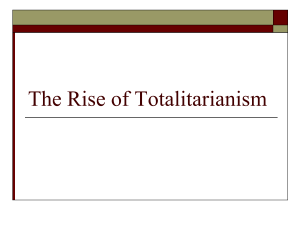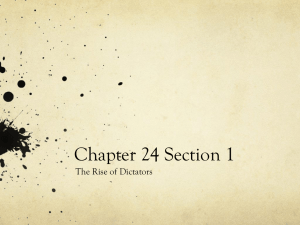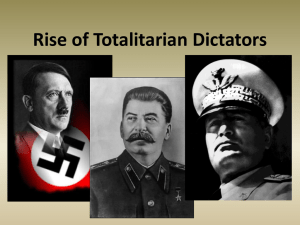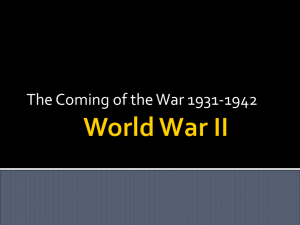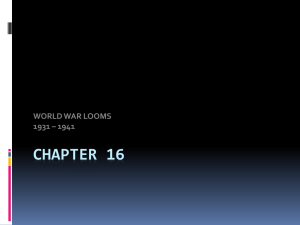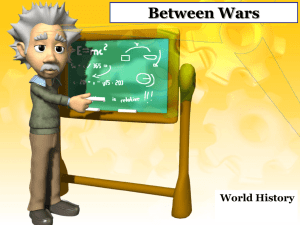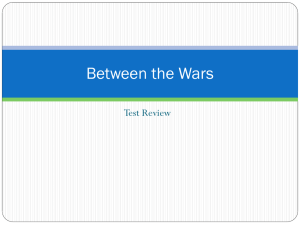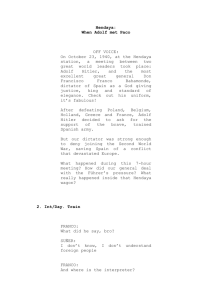The Rise of Totalitarianism
advertisement
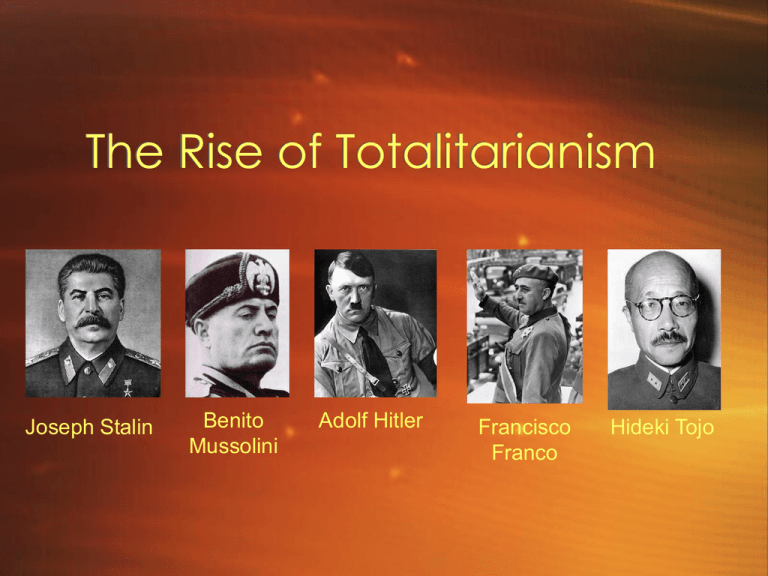
The Rise of Totalitarianism Joseph Stalin Benito Mussolini Adolf Hitler Francisco Franco Hideki Tojo Totalitarianism vs. Authoritarianism • 'Authoritarian' refers to the structure of government rather than to society. • Totalitarian regimes seek to control virtually all aspects of the social life. – Including: economy, education, art, science, private life and morals of citizens. Rise of Totalitarianism • Totalitarianism can be traced back to the Great War. – Attrition made required total effort – War required all institutions & individuals to subordinate their interests to victory • Russia (1917), Italy (1922), Germany (1933), Spain (1939), Japan (1926) Russia • Vladimir Lenin & emergence of USSR – After the Revolution in 1917 the Bolsheviks & Lenin had solidified control by 1923. • Lenin died in 1924 Joseph Stalin rose to power in Soviet Russia • Stalin pursued the policy of subordinating the individual to the ‘party’. Stalinism • “Stalinism”- Stalin’s style for the Soviet government – Stalin • Rejected dissent • Stalin = sole interpreter • World wide Communist revolution post-poned – Economic Changes • Rapid Industrialization (Five Year Plans) • Collectivization of Agriculture – Effective BUT… – Purges •Millions killed •Guilty executed or sent to Gulag Italy & WWI • WWI leaves Italy with many problems: – Heavy debts – Did not receive the land promised by France & G.B. – Rising unemployment led to unrest, particularly in cities. March on Rome March on Rome: October, 1922 – Coup d'état Mussolini's National Fascist Party rise to power in Italy – Ousted Prime Minister – King Victor Emmanuel III handed power to Mussolini. • Mussolini widely supported by military, business, & liberal right-wing. • Mussolini quickly moved to establish dictatorship Fascism • Fascism is a combination of many ideas – Corporatism: Power exercised through large organizations (businesses, trade unions) working with each other, directed by the state – Syndicalism: bringing industry & gov’t under control of labor unions – Nationalism, Expansionism, Social Progress, Anti-Communism in combination with censorship & state propaganda – Ideas of racial superiority Nationalism, Race &Fascism • Struggle of nation & race fundamental in society – Communists emphasized class struggle • Nations bind people by their ancestry • Nations are natural & good • Fascism sought to solve economic, political, and social problems via ‘national rebirth’ – Celebrates the nation & race above all else, – Cults of unity, strength and purity. Communism 1. History = class struggle 2. Nations are arbitrary class should unite the world 3. Global viewpoint 4. Gov’t runs industry Fascism 1. Struggle between nations & races 2. Nations are natural thus national pride is emphasized 3. National viewpoint 4. Gov’t has some control over industry Germany: Weimar Republic • A parliamentary republic established in 1919. • Faced numerous problems – Hyperinflation – Political extremists – War Reparations • Collapsed in the early 1930s Adolf Hitler • Austrian-born German • Decorated WWI veteran • Leader of the National Socilaist German Workers Party (NSDAP) better known as the Nazi Party Hitler • By 1921 Hitler & Oratory ability • Nazi Party: Centered in Munich – German nationalist movement • S.A. (Sturmabteilung) – Stormtroopers/”brown shirts” – Paramilitary organization • S.S. (Schutzstaffel) – Stormtroopers loyal to Hitler • Gestapo: official secret police of Nazi Germany Beer Hall Putsch November, 1923 • Failed Coup attempt • Hitler wanted to emulate the March on Rome • November 8th: Declares a new government in a Beer Hall • November 9th –The March Begins – To Bavarian War Ministry – Clash with police and march destroyed Arrest, Trial, Prison • Hitler arrested for High Treason • Trial • Uses trial as a platform • Gains noteriety & popularity • April 1924 – Sentenced to 5 years – Served less than one year • Mein Kampf: “My Struggle” – Part Autobiography part political rant – Helps spread his ideas. Strategy of Legality • Hitler changed his strategy to come to power. • The Strategy of Legality: – adhere to the rules of Weimar – Use the institutions of Weimar Republic to destroy it/come to power Depression, Election • By 1930 the Depression strikes Germany • President Paul von Hindenburg ran for re-election in 1932 – The only one who could defeat Hitler – Wins election – Has difficulty fending off Nazis • 1933 Hindenburg appointed Hitler Chancellor of Germany Reichstag Fire • February 1933: Reichstag set on fire • The fire began Hitler’s rise to total power – Reichstag Fire Decree (February ‘33) • Suspends civil liberties. – Enabling Act (March ’33) • Parliament gave Hitler's legislative powers. – Hindenburg dies (August ’34) • Hitler declared the office of President vacant • Hitler makes himself head of state or "Führer” Francisco Franco • Head of State of Spain from 1936-1975. • Franco's governance went through various phases • All emphasized: – – – – – Spanish nationalism Maintaining territorial integrity Catholicism Anti-Communism Emphasis on traditional values Spanish Civil War • 1936 -1939: It began after a coup by Spanish Army Generals • The war ended with the victory of the rebel forces – Republican gov’t overthrown – Dictatorship established with Franco at it’s helm. Guernica • Pablo Picasso depicts the bombing of Guernica by German & Italian war planes. The Empire of Japan • Rapid industrialization and Militarization emergence as a world power – Leads to membership in the Axis Alliance of WWII • Gained notoriety war crimes against the people within their Empire. Timeline • 1931-32 • 1937 – Japan invades – Japan – full scale invasion Manchuria of China (Rape of Nanking) • 1935: • 1938 – Italy invades Ethiopia – Anschluss: Germany invades/ annex Austria – Germany reintroduces Conscription (violation) – Hitler claims Sudetenland • 1936 – Germany seizes Czechoslovakia – Germany Remilitarized Rhineland • 1939 – Franco revolts against – Italy invades/annexes Spainish Gov’t. Albania – Tripartate Pact: – Hitler demands Danzig (Poland) – First Concentration Camps – Sept. 1, 1939



